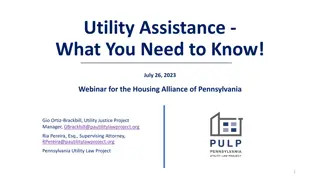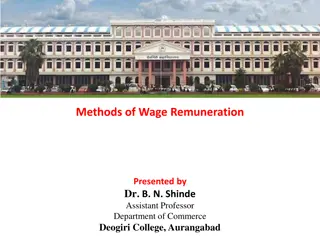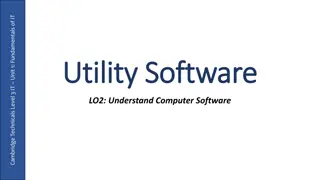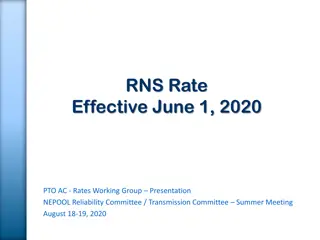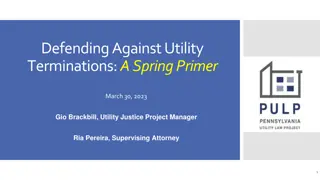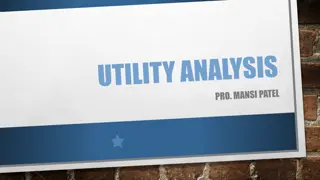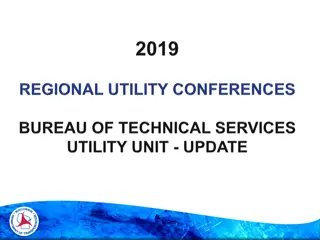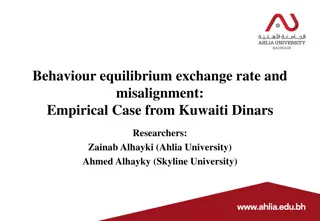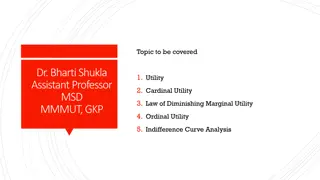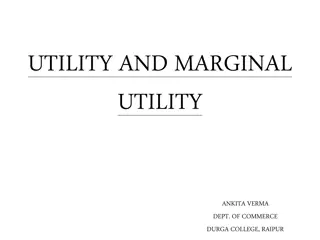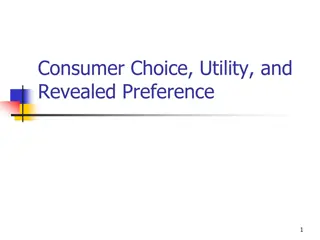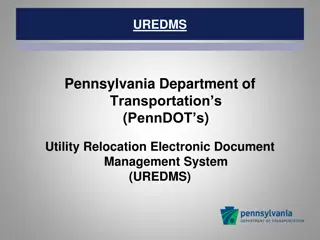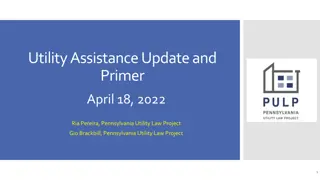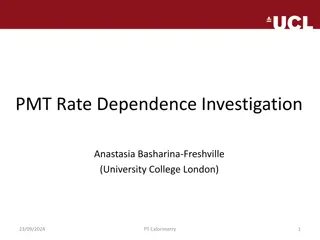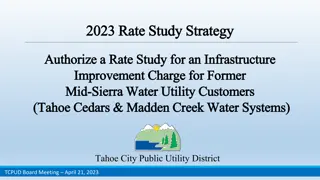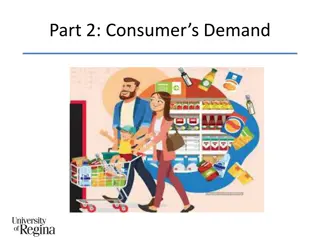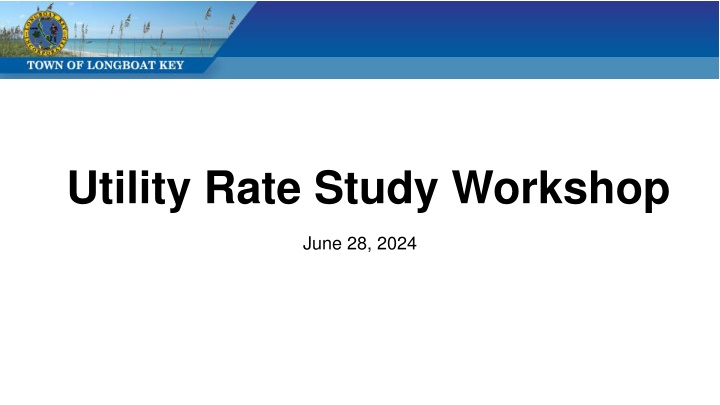
Utility Rate Study Workshop Overview
Utility Rate Study Workshop provides an essential service to water and wastewater customers, emphasizing public health and safety. The overview highlights the need for financial planning to maintain satisfactory operational performance and explains the key findings of the latest rate study, including capital cost changes and future forecasts.
Download Presentation

Please find below an Image/Link to download the presentation.
The content on the website is provided AS IS for your information and personal use only. It may not be sold, licensed, or shared on other websites without obtaining consent from the author. If you encounter any issues during the download, it is possible that the publisher has removed the file from their server.
You are allowed to download the files provided on this website for personal or commercial use, subject to the condition that they are used lawfully. All files are the property of their respective owners.
The content on the website is provided AS IS for your information and personal use only. It may not be sold, licensed, or shared on other websites without obtaining consent from the author.
E N D
Presentation Transcript
Utility Rate Study Workshop June 28, 2024
Utility System Overview Provides Essential Service on Continuous Basis to Approximately 2,950 Water Customers (10,500 Water Equivalent Living Units) and 2,500 Wastewater Customers (10,000 Wastewater Equivalent Living Units) Public Health and Safety Primary Objective Highly-Regulated (FDEP / SWFWMD / Department of Health) Permits Require Satisfactory Operating Performance Operations Funded Primarily Through Monthly User Rates About $60 Million Installed Cost of Depreciable Utility Assets Under Town Management Amount Would Be Much Higher If Right-Sized to Today's Dollars 2
Last Formal Rate Study Completed in 2021 Town Adopted Annual Increases Through Fiscal Year 2026: 5% Plus Pass-Through of Future Wholesale Rate Adjustments Wastewater Billing Cap for Single Family Residences Changed from 7,000 to 10,000 Gallons Town Implemented Pass-Through of Manatee County Wholesale Water and Wastewater Rate Increases Effective June 1, 2023 and June 1, 2024 Recommendation to Perform Another Financial Checkup or Rate Review at Least Once Every Three Years Proactive Financial Planning Helps to Avoid Large Future "Catch Up" Increases Current Rate Study Provides Update to Financial and Rate Plan Focuses on Changes in Town's Costs to Provide Service Other Than Manatee County Charges 3
Financial Forecast Have Prepared Financial Forecast Through Fiscal Year 2034 4
Changes in Capital Costs Since Last Rate Study Need for Rate Adjustments Primarily Driven By Need to Fund Two Major Capital Projects Current Cost Difference 2021 Rate Study Planning Cost Less Grant Funding Net Cost to Town Description Project Cost Amount Percent Wastewater Collection Subaqueous $21,892,633 $31,401,370 ($3,000,000) $28,401,370 $6,508,737 30% Asbestos Cement Pipe Replacements 6,781,000 9,557,000 (1,540,000) 8,017,000 1,236,000 18% Total $28,673,633 $40,958,370 ($4,540,000) $36,418,370 $7,744,737 27% With Grant Funding and Use of Cash Reserves, Assumed Financing Need of About $27 Million (Same Assumption as 2021 Rate Study) Current Study Assumes $26.9 Million Financing of Subaqueous Wastewater Main 5
Changes in Capital Costs Since Last Rate Study (cont.) Utility Infrastructure Is Often "Out of Sight, Out of Mind" Multi-Year Capital Improvement Program Recognized Summary of Critical Capital Needs Through the Fiscal Year 2034 Description Amount Wastewater Collection Subaqueous $31,401,370 Asbestos Cement Pipe Replacement Project 9,557,000 Allowance for Renewals and Replacements 5,126,791 Water Distribution Rehab/Water Main (Parallel) 2,822,510 Lift Station Rehab (Minor / Intermediate) 2,403,692 Rehabilitation of Sewer Lines 2,367,066 Wetwell and Manhole Repair 1,398,460 Meter Replacement Program 1,385,444 SCADA Upgrade 1,281,970 Other 11,248,118 Total Capital Needs $68,992,420 Revenue/Cash-Funded Capital Needs of $42.1M 6
Financing Options for Wastewater Collection Subaqueous Town MUST Complete Project Clean Water State Revolving Fund (SRF) Loan Program Assumed Interest Rate of 2.89% 20-Year Term Annual Payment of $1.9 Million Total Cost to Town = $37.6 Million (20 Years of Payments) REQUIRES REFERENDUM PER TOWN CHARTER LANGUAGE AND LANGUAGE IN STANDARD SRF LOAN AGREEMENT (Most Likely March 2025 Election Cycle) 30-Year Revenue Bonds Line of Credit or Bond Anticipation Note for Fiscal Year 2026 and 2027 Spending Assumed Interest Rate of 5.51% 30-Year Term Annual Payment of $1.9 Million Total Cost to Town = $58.5 Million (30 Years of Payments Plus Line of Credit Payments) Additional $20.9 Million Cost to Town Compared With SRF Loan Option NO REFERENDUM REQUIRED 7
Financing Options for Wastewater Collection Subaqueous (cont.) Town MUST Complete Project 20-Year Revenue Bonds Line of Credit or Bond Anticipation Note for Fiscal Year 2026 and 2027 Spending Assumed Interest Rate of 5.00% 20-Year Term Annual Payment of $2.2 Million Total Cost to Town = $45.9 Million (20 Years of Payments Plus Line of Credit Payments) Additional $8.3 Million Cost to Town Compared With SRF Loan Option NO REFERENDUM REQUIRED Estimated Additional 4% Rate Increase Needed Compared With SRF Loan or 30-Year Revenue Bonds Asset Life Is Greater Than 20 Years Interperiod Equity Considerations 8
Town Charter Language and SRF Loan Standard Language Town Charter Language The town or any public entity controlled by the town may issue revenue bonds in excess of the Bonding Limitation at any one time only when approved by vote of the qualified electors. For purposes of this limitation, "at any one time" means within 90 days and "Bonding Limitation" means $5,000,000.00 initially. As of each October 1 thereafter, the amount of the "Bonding Limitation" in effect shall be adjusted to reflect the percentage change in the Consumer Price Index (U.S. City Average All Workers) by using the most recent available information for the prior 12 month period. The town commission may waive the requirement for a vote of the electors for said revenue bonds if it determines, in its sole discretion, that there exists an emergency such that it is in the best interest of the town to issue the bonds without a vote of the electors. Notwithstanding the above, a vote of the electors shall not be required to refund outstanding bonds and interest and redemption premium thereon at a lower net average interest cost rate, to issue any revenue bonds payable exclusively from non-ad valorem revenues in the proprietary funds, or to incur any obligation which is subject to annual appropriation. 9
Town Charter Language and SRF Loan Standard Language (cont.) SRF Loan Standard Language In the event the anticipated Pledged Revenues are shown by the Local Government's annual budget to be insufficient to make the Semiannual Loan Payments for such Fiscal Year when due, the Local Government shall include in such budget other legally available non-ad valorem funds which will be sufficient, together with the Pledged Revenues, to make the Semiannual Loan Payments. Such other legally available non-ad valorem funds shall be budgeted in the regular annual government budget and designated for the purpose provided by this Subsection, and the Local Government shall collect such funds for application as provided herein 1 0
Changes in Operating Costs Since Last Rate Study Fiscal Year 2025 Operating Costs Other Than Manatee County Charges Are 14.4% Higher Than Projected in 2021 Rate Study and Are Anticipated to Continue Increasing Florida's Inflation Currently Outpacing National Trends Utility Has Limited Control Over Many Operating Costs (e.g., Electricity, Chemicals) Nationwide Issues With Filling Positions and Keeping Employees o A Well-Trained, Experienced, and Sufficient Utility Staff Is Critical for Effectively Running Utility 24 Hours Per Day and 365 Days Per Year, for Maintaining Level of Service, and for Emergency Preparedness (e.g., Hurricanes) Due to Regulatory Environment, Utility Costs Normally Increase at a Higher Rate Than CPI Permanent Increases in Costs Must Ultimately Be Passed Through to Customers Through Rates 11
Need to Preserve Access to Capital Markets Given Current Volatile Market Conditions, Recommend 200% All-In Debt Service Coverage Target Supported By Credit Rating Agencies and Town's Financial Advisor o Fitch Median for AA-Rated Utilities = 250% Provides More Assurance That Utility Will Meet Coverage Requirements Revenues After Payment of Operating Expenses and Debt Service Should Ideally Be at Least Equal to Annual Depreciation Expense (Annual "Wear and Tear" on System) 12
Revenue Requirements Analysis Projected Need to Adjust Rates to Keep Utility Sustainable 13
Financial Risks of Not Adjusting Rates Inability to Issue New Debt for Critical Capital Needs Inability to Fund All Revenue Requirements, Fund Capital Program, and Meet Financial Targets User Rates Will Be Even Higher in the Future Capital Needs for Utility Will Not Go Away, But Will Be More Expensive to Address in the Future; Risk of Future Fines and Consent Orders If Infrastructure Failures Cause Pollution or Utility Does Not Comply With Regulatory Requirements Inflation in Operating and Construction Costs Continues to Affect System Costs to Provide Service 14
Rate Plan Options Summary of Proposed User Rate Revenue Adjustments Best Financial Management Practices: Smaller, Incremental Increases Over Time Help to Avoid Future "Rate Shock" and Higher "Catch Up" Rate Increases % of Median Household Income (<4.5% Considered Affordable By EPA) [3] 0.8% Bill for Average SFR Customer Using 5,000 Gallons $ Total Cost Per Gallon of Water and Sewer Service [2] Proposed Revenue Adjustment [1] Increase in SFR Customer Monthly Bill Fiscal Year Effective Date Existing - Effective June 1, 2024 SRF LOAN OPTION (REQUIRES REFERENDUM) 97.76 Recommend Adoption of Five (5) Years of Rate Adjustments Lenders and / or Credit Rating Agencies Want to See That Plan to Support Debt Has Been Adopted Recommend Performing Another Financial Checkup or Rate Review at Least Once Every Three Years, or If Circumstances Change Significantly 2025 2026 2027 2028 2029 30-YEAR REVENUE BONDS OPTION October 1, 2024 October 1, 2025 October 1, 2026 October 1, 2027 October 1, 2028 8.0% + PTA 8.0% + PTA 8.0% + PTA 7.0% + PTA 3.0% + PTA 105.59 114.02 123.13 131.78 135.68 $7.83 8.43 9.11 8.65 3.90 2.1 2.3 2.5 2.6 2.7 0.9% 0.9% 1.0% 1.0% 1.0% 2025 2026 2027 2028 2029 [1] PTA = Pass-Through Adjustments of future Manatee County wholesale rate inceases October 1, 2024 October 1, 2025 October 1, 2026 October 1, 2027 October 1, 2028 9.0% + PTA 9.0% + PTA 9.0% + PTA 3.5% + PTA 3.5% + PTA 106.54 116.14 126.59 130.99 135.60 8.78 9.60 10.45 4.40 4.61 2.1 2.3 2.5 2.6 2.7 0.9% 0.9% 1.0% 1.0% 1.0% [2] Based on proposed rates applied to single family residential ("SFR") customer with 5,000 gallons of monthly usage. [3] EPA = United States Environmental Protection Agency. Assumes annual 3% cost of living salary increases after Fiscal Year 2024 15
Projected Financial Position (cont.) Amounts Available for Pay-As-You-Go Capital Funding Vs. Annual Depreciation Expense Fiscal Year 2025 Fiscal Year 2029 Fiscal Year 2034 Description Net Revenues $3,610,041 $5,995,597 $5,064,680 Total Debt Service 969,093 2,847,728 1,881,248 Debt Service Coverage 373% 211% 269% Amount Available for Pay-As-You-Go Funding After Payment of Debt $2,640,948 $3,147,870 $3,183,432 Annual Depreciation Expense [*] $2,427,282 $2,731,927 $3,167,052 [*] Assumed to increase by 3% per year. 17
User Rate Comparison 5,000 Gallons of Monthly Usage Bills Under Rates Effective in June 2024 [*] Utility is currently involved in a rate study, is planning to conduct a rate study, or plans to implement a rate revision or price index / pass-through adjustment within the next twelve months following the comparison preparation date 18
User Rate Comparison 10,000 Gallons of Monthly Usage Bills Under Rates Effective in June 2024 [*] Utility is currently involved in a rate study, is planning to conduct a rate study, or plans to implement a rate revision or price index / pass-through adjustment within the next twelve months following the comparison preparation date 19
Rate Comparison Not a "Report Card" on How Well Utility Is Performing Some Reasons Why User Rates Differ Among Utilities Size of Existing Customer Base / Available System Growth Demographics (e.g., Customers Spread Out vs. Close Together, Types of Customers Served) Level of Capital Improvements to Meet Service Area Growth Amount of Needed Renewals and Replacements / Remaining Service Life of Assets Differences in Bond Covenants Source of Water Supply and Treatment Process Costs Plant Capacity Utilization and Assistance in Funding of Such Capacity (e.g., Grants, Impact Fees) Time of Last Rate Review Amount of General Fund and Administrative Fee Transfers 20
Requested Commission Action Provide Direction on Financing Alternative Lowest Cost Financing Option (SRF Loan) Requires Referendum Recommendation to Adopt Proposed Schedule of Water and Wastewater User Rate Increases for Fiscal Years 2025 to 2029 Smaller, Incremental Rate Increases Over Time Help to Avoid Future Large "Catch Up" Increases Preserves Access to Capital Markets o When Evaluating Utility's Ability to Repay Debt, Credit Rating Agencies and Lenders Will Only Consider Rate Increases That Have Been Adopted o 100% Pay-As-You-Go Funding of Capital Program Would Require Much Higher Rate Increases Staff Needs to Know Revenue Stream to Implement Multi-Year Capital Program Since Projects Usually Take More Than One Year to Complete o Funding Must Be in Place to Enable Bidding for Projects Rates Considered Competitive and Affordable 21
Requested Commission Action (cont.) Monitor Actual Vs. Projected Financial Results Changes in Economic Conditions, Customer Usage Trends, Regulatory Environment, Capital Needs, Etc. Update Financial and Rate Plan as Needed Financial Checkup or Review at Least Once Every Three Years 22



